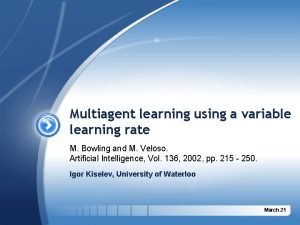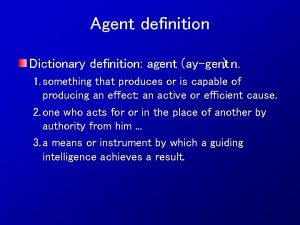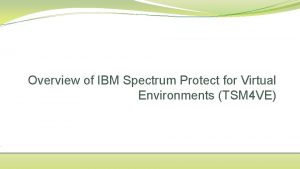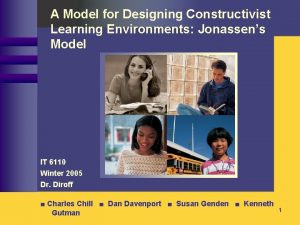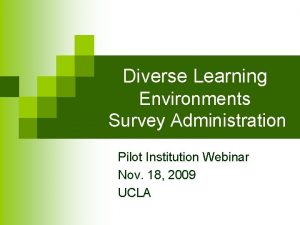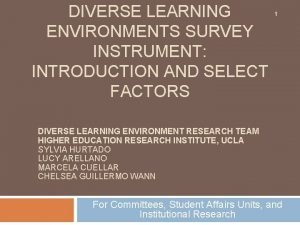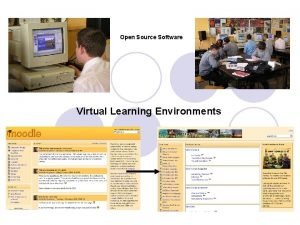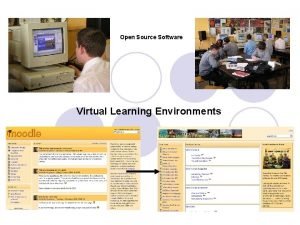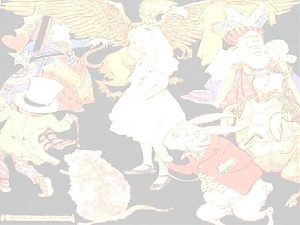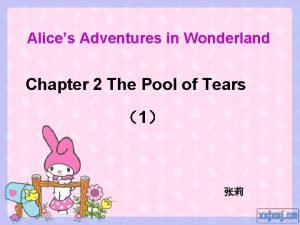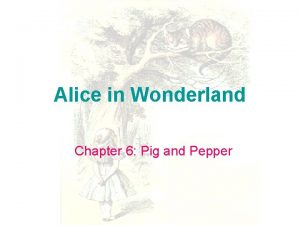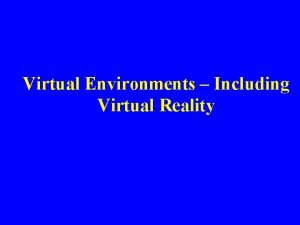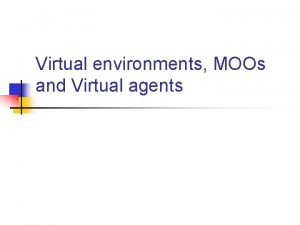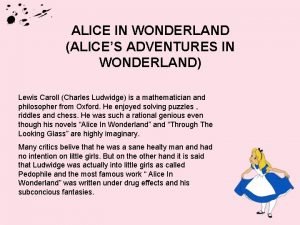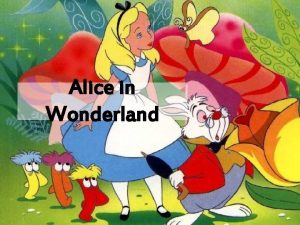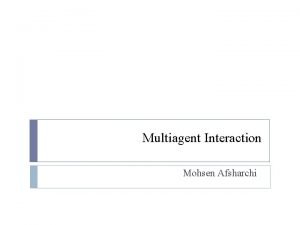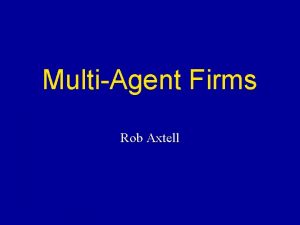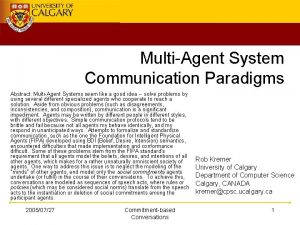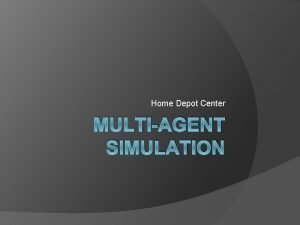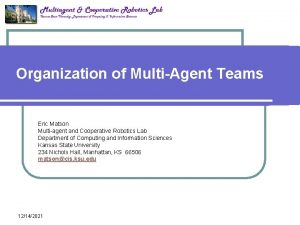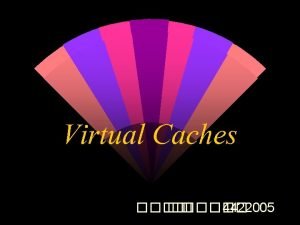Open Wonderland Multiagent Virtual Learning Environments Oscar Lin















- Slides: 15

Open Wonderland Multiagent Virtual Learning Environments Oscar Lin Steve Leung School of Computing and Information Systems Faculty of Science and Technology January 13, 2012 Athabasca University, Canada

Virtual Worlds for e-Learning • more dimensions than physical environments • more social than social network software • nuanced ways (able to show slight difference that may be difficult to notice but are fairly important • more engaging than physical classrooms

Approaches • Virtual classrooms, e. g. – Second life, Virtual. PREX – Providing Virtual Professional Experience for Pre-Service Teachers • Fantasy worlds, e. g. – Virtual Singapura

Problems • Knowledge and Intelligence – – Serious games, simulations Usability Pedagogical value Complexity of game functions and pedagogy functions. • • • Assigning a game Educational resource/user management Scenario generation Score-keeping Providing hints • Interactiveness and immersion – Realistic, engaging, and immersive • modeling the virtual students and virtual audience which are implemented as NPCs or bots. • Adaptivity and personalization – Keeping track of individual interests, preferences, motivations, and goals of the human participants (i. e. , learners) and building user/student models.

Intelligent Virtual Worlds for e-Learning • Desirable features – Smart – Engaging – Effective – Usable • Agent technology – Sensory ability – Reasoning capability – Social ability • Roles of the agents – Functional modules – Non-player characters (NPCs) – Personal agents • Challenges – User modeling – Decision making – Coordination

Quiz Games in Classrooms • In classrooms, teachers usually use quiz games to create some interesting activities. • The purposes of Quiz Games for the classes – Good for reviewing and reinforcing previously taught material – Good for warming up or ending lesson on a high – A quiz encapsulates the basic unit of conversation

Quiz Master • Quiz master – A TV game show, where a small group of contestants compete by answering questions presented by the game show host. Host - Pedagogical agent

Purpose of the Project • • • Build Quiz. MASter • a virtual world based educational application that mimics a quiz game in classrooms. To build engaging, affectionate, and effective pedagogical agents which is the virtual host in Quiz. MASter. Team members: – – – – – Adien Dubbelboer (FHSS) Steve Leung (FST) Sandeep Virwaney (BSc CIS) AJ Armstrong (NAIT, MSc IS) Sima Shabani (MSc IS) Steeve Leberge (MSc IS) Mike Proctor (MSc IS) Martin Weng (visiting Ph. D student, Taiwan) Bob Heller (FHSS) Oscar Lin (FST)

Open Wonderland Architecture

Agents Architecture • Agents are encapsulated computer systems that are designed to behave flexibly and somewhat autonomously to achieve some goal(s). • Agents are situated in some environment and have some autonomy and capabilities to observe that environment. • They can communicate those observations to other agents. This makes them particularly suited to distributed environments. • Within the distributed environment, the Multi-Agent System (MAS) can be designed using one or more architectures. • The autonomous nature of agents implies that the architecture can even develop dynamically at run-time.

Architecture (1) • As an initial step, we integrated Open Wonderland JADE through the starting of a JADE server separate from Open Wonderland – Jeanne and Lin, 2011

Architecture (2) • Add a Jason module to Open Wonderland that takes an NPC and controls its movement in the environment. • The NPC runs on the Open Wonderland server and pulls an Agent. Speak() asl file from the file system, sets up its belief system and goals, and then runs. • The Open Wonderland module system makes it simple to extend Open Wonderland to include the framework and any other functionality that is required.

CArt. Ag. O-based Architecture (3) • Common ARTifact infrastructure for AGents Open environments • A general purpose framework that makes it possible to program and execute virtual environments for multi-agent systems. • Based on the Agents & Artifacts (A&A) meta-model for modeling and designing multi-agent systems. • Enables customization of the rendering of visible artifacts for different clients

Scenario • Participants – Contestants (4~6) – The host – The Audience • Subject – ENGL 255 • Process of a Quiz. MASter session – The host greets the contestants – The audience will be cheering for and looking at all the contestants simultaneously. – Questions are displayed. – Contestants will answer the questions. Scores will be kept. Hints will be provided if needed. • Video: • http: //oscar. athabascau. ca/Quiz. MAster_Lin. avi

Future Work • Proofs: – We are planning for an experiment to test the effectiveness of the platform. – Comparison of TSI enhanced approach and non-TSI enhanced approach – Measurement of the effectiveness to achieve the learning goals • Enhancement of TSI features – Morphing (how accurate of the morphed features is) – Sensory abilities • There a lot of senses we can mimic – Situational contexts • There a lot of situational information we can process • Modeling of contestants • Agents intelligence: agent learning • Multi-agent intelligence – Emerging behaviour of pedagogical agent in quizzes feedback generation.
 Multiagent learning using a variable learning rate
Multiagent learning using a variable learning rate Gent urban dictionary
Gent urban dictionary Ans1311e server out of data storage space
Ans1311e server out of data storage space Designing constructivist learning environments
Designing constructivist learning environments Diverse learning environments survey
Diverse learning environments survey Diverse learning environments survey
Diverse learning environments survey Btogrenme/moodle
Btogrenme/moodle North chadderton vle
North chadderton vle 영국 beis
영국 beis Cuadro comparativo e-learning b-learning m-learning
Cuadro comparativo e-learning b-learning m-learning What is the falling action of alice in wonderland
What is the falling action of alice in wonderland Alice in wonderland math
Alice in wonderland math Hardboiled wonderland
Hardboiled wonderland Alice in wonderland chapter 2 pdf
Alice in wonderland chapter 2 pdf Duchess (alice's adventures in wonderland)
Duchess (alice's adventures in wonderland) Chapter 6 alice in wonderland
Chapter 6 alice in wonderland
